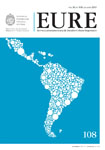Organized crime: divergent order and vulnerable urban neighborhoods
DOI:
https://doi.org/10.4067/S0250-71612010000200003Keywords:
urban structure, socio-territorial transformations, violenceAbstract
In criminology, organized crime is associated with the planning of illegal activities and complex structures of organizations. In the economy of crime, the distinctive attribute is the offer of protection and an alternate justice to that of government or state. In effect, organized crime will enter into urban neighborhoods using different kinds of social interaction among inhabitants and with unequal distribution through the whole city. The neighborhoods with examples of organized crime (homicides and burglaries) in Bogota were identified using quantitative and descriptive information, as well as cartographic resources. Field observationÍ€™s as well as in depth interviews have revealed three types of neighborhood which exhibit favorable conditions for the presence of organized crime. The remote area: the violent control of the youthful population is the precursor to the regulation of the inhabitantsÍ€™ daily lives. Neighborhoods in transition: illegal markets and their forms of regulation are positioned along with commercial activities, which connect Bogota with the rest of Colombia. The gated community: The interrelations of neighbor and neighborhood are weakened because of private security; which facilitates the infiltration of organized crime.
ÍDownloads
Published
How to Cite
Issue
Section
License
Copyright (c) 2010 Revista EURE - Revista de Estudios Urbano Regionales

This work is licensed under a Creative Commons Attribution 4.0 International License.
Al momento de aceptar la publicación de sus artículos, los autores deberán formalizar la cesión de derechos de autor a EURE, según las condiciones establecidas por la Revista.
Ésta establece que el autor autoriza a EURE de manera gratuita, exclusiva e ilimitada a reproducir, editar, publicar, distribuir, publicitar, comercializar y traducir el artículo, a cualquier soporte conocido o por conocer y desarrollar.
Del mismo modo, los autores aseguran que el artículo propuesto es original, no publicado y no propuesto para tal fin a otro medio de difusión.


